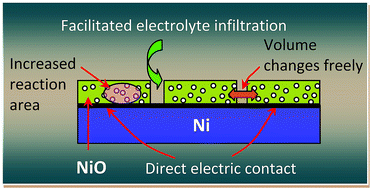Cracks bring robustness: a pre-cracked NiO nanosponge electrode with greatly enhanced cycle stability and rate performance†
Abstract
The practical application of faradaic capacitors is hampered by electrodes' volume change in the charge/discharge process, which leads to the disintegration of the electrode structure and inferior long-term stability. It is desirable while challenging to develop a low cost and facile method to fabricate an electrode which can effectively accommodate volume expansion/contraction and alleviate the concomitant stress. Herein, taking NiO as an example, a promising route to solve the above issue is demonstrated by purposely introducing cracks in a NiO nanosponge through rapid thermal quenching. The NiO nanosponge is cracked into discrete islands with a size of several micrometers, with each unit strongly connected to a conductive nickel substrate. The small islands of NiO are capable of expanding/contracting freely during repeated charge/discharge processes, leading to a stable mechanical structure and excellent long-term durability. The pre-cracked NiO nanosponge outperforms many state-of-the-art Ni-based electrode materials, with a remarkable rate performance of 1546 F g−1 at 10 mV s−1 and 1109 F g−1 at 200 mV s−1 and no capacitance decay after 5000 cycles. The idea of relieving stress through thermally induced cracks is facile and effective. This will not only help the design of Ni-based electrode materials but also be extended to other transition metal compounds for the performance optimization.


 Please wait while we load your content...
Please wait while we load your content...